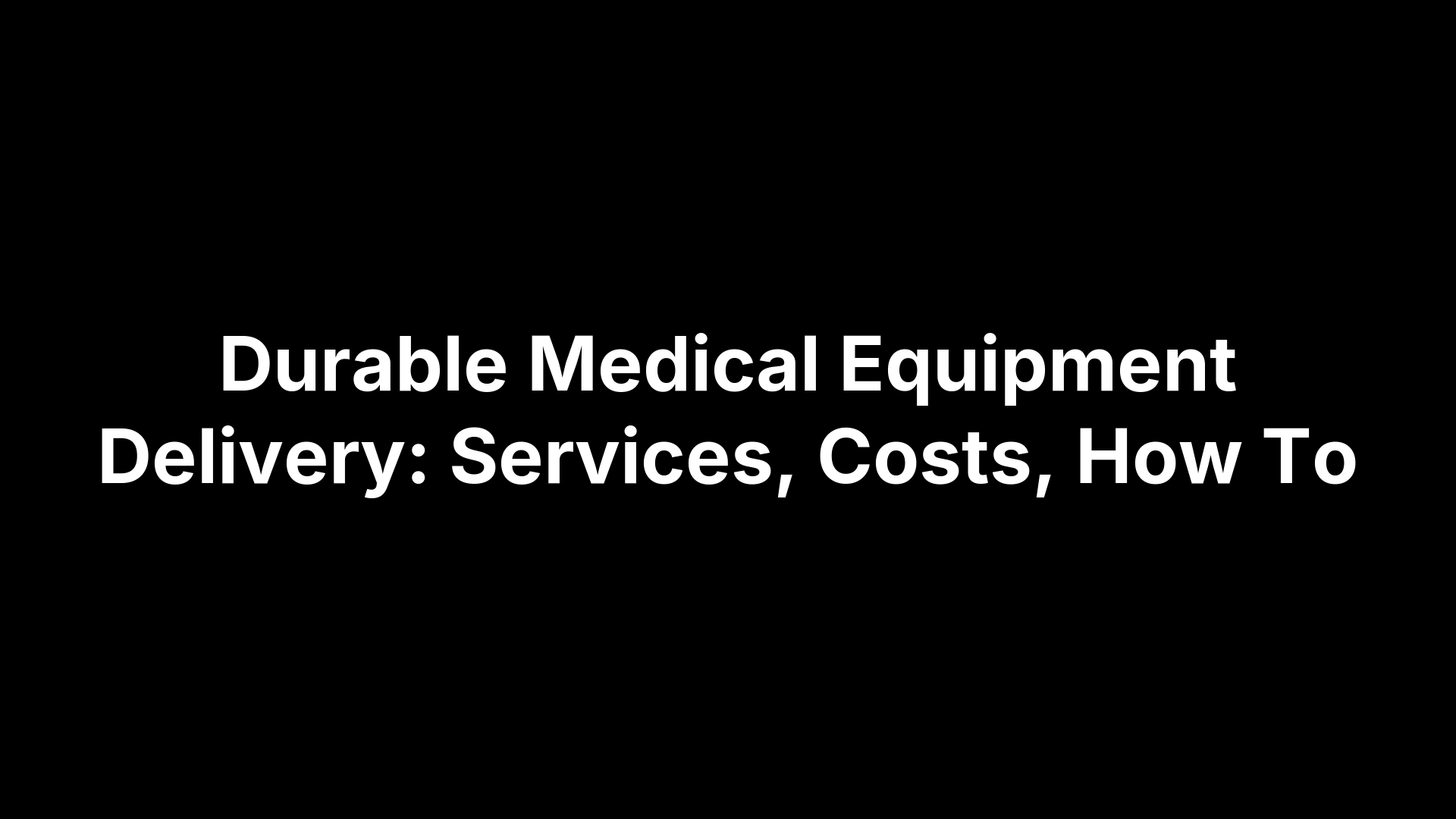Durable Medical Equipment Delivery: Services, Costs, How To


Durable Medical Equipment Delivery: Services, Costs, How To
Durable medical equipment delivery brings medical devices and supplies directly to patients at home or to healthcare facilities. This includes wheelchairs, hospital beds, oxygen concentrators, walkers, CPAP machines, and other equipment people need for recovery or ongoing care. Most DME providers offer scheduled or same day delivery, setup, and instruction so patients can safely use the equipment right away.
You need to understand how DME delivery works if you coordinate patient care, manage hospital discharges, or run a home health agency. This guide covers how to arrange delivery, what equipment qualifies, typical costs and insurance coverage, and what to look for when choosing a delivery partner. You'll learn the practical details that help you get equipment to patients quickly and reliably.
Why durable medical equipment delivery matters
Timely equipment delivery directly affects patient recovery and hospital operations. When you get wheelchairs, oxygen equipment, or hospital beds to patients on schedule, you prevent delayed discharges, reduce readmissions, and help people start their recovery at home faster. Delays create bottlenecks that cost facilities money while forcing patients to wait in hospital beds they no longer need.
Patient safety and recovery outcomes
You put patients at risk when equipment arrives late or without proper setup. A 72-year-old patient waiting for a walker might attempt to move without assistance and fall. Someone discharged without their prescribed oxygen concentrator faces serious health complications. Professional durable medical equipment delivery services set up devices correctly, demonstrate how to use them, and verify everything works before leaving. This hands-on support reduces equipment-related accidents and helps patients follow their care plans from day one.
Proper DME delivery transforms discharge planning from a coordination nightmare into a streamlined process that serves patients and facilities alike.
Operational efficiency for healthcare facilities
Your facility saves significant time and money when you work with reliable DME delivery partners. Hospital staff spend hours coordinating equipment pickups, tracking deliveries, and troubleshooting delays. These administrative tasks pull nurses and care coordinators away from direct patient care. A dependable delivery system cuts this coordination time by 70% or more, freeing your team to focus on clinical work. You also reduce bed occupancy costs by moving patients home as soon as they're medically ready instead of waiting days for equipment to arrive.
Facilities without streamlined DME delivery face higher readmission rates because patients lack the equipment they need at home. This creates quality of care issues and financial penalties under value-based payment models.
How to arrange durable medical equipment delivery
You start the durable medical equipment delivery process by securing proper medical authorization and connecting with the right suppliers. The steps vary slightly depending on whether you work in a hospital, home health agency, or coordinate care for individual patients. Most arrangements take 24 to 72 hours from initial order to delivery, though urgent cases can happen same day when you work with responsive providers.
Getting a prescription and medical documentation
Your physician must write a prescription or certificate of medical necessity before any DME supplier can fulfill an order. This document specifies exactly what equipment the patient needs, why they need it, and how long they'll use it. Insurance companies require this paperwork to approve coverage, and suppliers cannot legally deliver most durable medical equipment without it. The prescription should include detailed specifications like wheelchair dimensions, oxygen flow rates, or bed weight capacity to prevent ordering the wrong equipment.
Documentation needs vary by equipment type. Simple items like walkers might only need a basic prescription, while complex devices like ventilators require comprehensive medical records and detailed justification. You save time by gathering all necessary documents upfront rather than dealing with delays when suppliers request additional paperwork.
Choosing a DME supplier
You select suppliers based on insurance network participation, delivery capabilities, and service area coverage. Start by checking which providers your patient's insurance company contracts with, since out-of-network suppliers often mean higher costs or denied claims. Call potential suppliers to verify they stock the specific equipment you need and can deliver within your required timeframe.
The right supplier delivers equipment on schedule, handles insurance billing directly, and provides setup support without multiple follow-up calls.
Compare delivery options carefully. Some suppliers only deliver on specific weekdays, while others offer same day or weekend service for urgent needs. Ask about setup and training services because patients benefit most when delivery staff demonstrate equipment use and answer questions on site. Geographic coverage matters too since rural areas often have fewer provider options and longer delivery windows.
Scheduling and confirming delivery details
You coordinate delivery by providing the supplier with complete patient information, delivery address, preferred time windows, and any special access requirements. Be specific about scheduling constraints. If your patient lives in an assisted living facility or has limited mobility, the supplier needs to know this in advance so they send appropriate personnel and plan extra time for setup.
Confirm delivery appointments 24 hours ahead and get direct contact information for the delivery team. This prevents miscommunications about timing or location. Share the patient's phone number with the supplier so drivers can call if they're running late or need directions. For facility deliveries, designate a staff contact person who can receive the equipment and sign delivery confirmations.
Track the delivery status through the supplier's system if they offer online tracking. When equipment doesn't arrive as scheduled, contact the supplier immediately rather than waiting. You maintain backup plans by identifying alternative suppliers who can fulfill urgent orders if your primary provider experiences delays or stockouts.
Types of durable medical equipment and delivery options
You encounter dozens of equipment categories when coordinating durable medical equipment delivery, each with specific delivery requirements and timing considerations. Understanding what qualifies as DME and how different delivery models work helps you match patients with the right equipment through the most efficient service option. Common equipment types include mobility devices, respiratory support systems, home hospital furniture, and therapeutic devices that patients use for extended periods during recovery or ongoing care management.
Mobility and ambulation equipment
Your patients need mobility devices like wheelchairs, walkers, rollators, canes, and crutches more often than any other DME category. These items help people move safely at home after surgery, injury, or when managing chronic conditions that affect balance and strength. Wheelchairs range from basic manual models to complex power chairs with custom seating systems. Walkers come in standard, wheeled, and bariatric versions to accommodate different patient needs and weight capacities.
Delivery services for mobility equipment typically include basic assembly and height adjustment at no extra charge. Manual wheelchairs and standard walkers arrive ready to use within 24 hours through most suppliers. Power wheelchairs require longer lead times because suppliers must verify insurance approval, order custom components, and schedule technician visits for setup and patient training.
Respiratory and oxygen equipment
Oxygen concentrators, CPAP machines, BiPAP devices, and nebulizers serve patients with respiratory conditions who need breathing support at home. Oxygen equipment comes in stationary concentrators for home use and portable systems for patients who remain mobile. CPAP machines treat sleep apnea and require mask fitting plus pressure settings programmed to match physician orders.
These devices demand specialized delivery protocols because they're life-sustaining equipment. Suppliers send trained respiratory therapists who set up machines, verify proper function, teach patients how to operate controls and maintain equipment, and ensure backup power sources work correctly. You schedule these deliveries carefully because patients cannot safely leave the hospital until oxygen support starts working at home.
Respiratory equipment delivery requires technical expertise that goes beyond simple drop-off service, making supplier qualifications critical for patient safety.
Home hospital equipment and patient care devices
Hospital beds, patient lifts, commodes, shower chairs, and wound care supplies help you transform home environments into safe care settings. Adjustable hospital beds prevent pressure ulcers and help patients position themselves comfortably without assistance. Patient lifts protect caregivers from injury when moving individuals with limited mobility. Bathroom safety equipment like raised toilet seats and grab bars reduce fall risks in high-danger areas.
Delivery teams install this heavier equipment and anchor safety devices to walls or floors when necessary. They demonstrate bed controls, lift operation, and proper transfer techniques so family caregivers feel confident using the equipment. Installation appointments take 45 to 90 minutes depending on how many items require setup.
Delivery service models and timing options
You choose between scheduled delivery, same-day service, or standing orders based on patient urgency and equipment availability. Scheduled deliveries work for planned discharges when you know the exact date patients go home. Same-day service costs more but solves urgent situations like unexpected early discharges or equipment failures. Some facilities establish standing orders with suppliers who automatically deliver commonly needed items within specific timeframes.
White glove delivery includes equipment setup, patient education, and removal of packaging materials. Basic delivery drops equipment at the door without assembly or instruction. You pay premium rates for white glove service but gain peace of mind that patients receive proper training and equipment functions correctly before the delivery team leaves.
Costs, insurance, and billing basics
You face a complex payment landscape when coordinating durable medical equipment delivery because costs depend on insurance coverage, equipment type, rental versus purchase decisions, and supplier billing practices. Equipment expenses range from $50 for basic walkers to $15,000 for power wheelchairs, with insurance typically covering a portion after you meet deductibles and copayments. Understanding billing structures and coverage rules helps you set accurate patient expectations and avoid surprise charges that delay discharge planning.
Understanding DME pricing structures
Your costs vary significantly based on whether you rent or purchase equipment. Insurance companies and Medicare prefer rentals for items patients need temporarily, like hospital beds during recovery from surgery. You rent these items for monthly fees that range from $100 to $500 depending on the device. After 13 months of continuous rental payments, Medicare considers the equipment purchased and ownership transfers to the patient.
Purchase options work better for equipment patients need long-term. Wheelchairs, walkers, and oxygen concentrators often cost less to buy outright if you know the patient will use them for years. Suppliers quote purchase prices that include delivery, setup, and initial training. Some providers offer rent-to-own programs that apply rental payments toward the purchase price, giving you flexibility if the patient's condition changes unexpectedly.
Delivery fees add $50 to $200 to your total costs depending on distance, equipment weight, and setup complexity. Most suppliers include basic delivery in their quoted prices but charge extra for same-day service, weekend delivery, or locations beyond their standard service area. You save money by scheduling deliveries during regular business hours and grouping multiple items into single delivery appointments.
Medicare, Medicaid, and private insurance coverage
Medicare Part B covers 80% of approved DME costs after you meet the annual deductible, leaving patients responsible for the remaining 20% coinsurance. Coverage applies only when physicians document medical necessity and you order from Medicare-approved suppliers. Medicaid programs vary by state but generally provide more comprehensive DME coverage with lower patient cost-sharing than Medicare.
Insurance approval timelines directly affect how quickly you can arrange durable medical equipment delivery, making it critical to submit complete documentation from the start.
Private insurance plans establish their own DME coverage policies and supplier networks. You verify benefits before ordering by calling the insurance company with the specific equipment codes and confirming whether the supplier participates in their network. Out-of-network suppliers can deliver equipment, but patients pay significantly higher costs or receive no coverage at all. Prior authorization requirements add 3 to 7 business days to the delivery timeline for complex equipment like power wheelchairs or advanced respiratory devices.
Out-of-pocket costs and payment options
Your patients face deductibles, coinsurance, and copayments even with insurance coverage. A $1,500 hospital bed might cost a Medicare patient $300 after the 20% coinsurance, while someone with commercial insurance pays anywhere from $0 to the full amount depending on their plan design. Patients who haven't met annual deductibles pay full equipment costs until they reach that threshold.
Financial assistance programs help patients who cannot afford their cost-sharing obligations. Many DME suppliers offer payment plans that spread costs over 6 to 12 months with no interest charges. Nonprofit organizations and equipment loan programs provide free or low-cost devices to qualifying patients. You connect patients with these resources during discharge planning to prevent financial barriers from delaying equipment delivery and recovery at home.
Suppliers handle insurance billing directly in most cases, but you verify this arrangement upfront. When patients pay out-of-pocket, suppliers require full payment or deposits before delivery. Cash prices often run 10% to 30% lower than insurance-billed amounts because suppliers avoid administrative costs and payment delays associated with insurance claims processing.
What to look for in a DME delivery partner
You need a durable medical equipment delivery partner who consistently meets deadlines, communicates proactively, and handles both routine and urgent requests without creating administrative headaches for your team. The right provider becomes an extension of your care coordination staff rather than another vendor you constantly chase for updates. Reliability, coverage area, and service capabilities separate partners who streamline your operations from those who create bottlenecks that delay patient discharges and increase your operational costs.
Service reliability and delivery speed
Your partner must deliver equipment on time at least 95% of occasions because missed delivery windows directly affect bed turnover and patient satisfaction scores. Ask potential providers for performance metrics showing their on-time delivery rates, average response times for urgent orders, and how they handle equipment failures or delivery delays. Providers with same-day delivery capabilities for common items like wheelchairs and walkers solve urgent discharge situations that otherwise force patients to stay overnight unnecessarily.
Communication systems matter as much as delivery speed. You want partners who send automated status updates via text or email so you track shipments without making phone calls. Real-time tracking prevents the constant "where's my delivery" questions that waste your staff's time. Partners should proactively contact you about potential delays rather than waiting for you to discover problems when equipment fails to arrive.
The best delivery partners solve problems before you know they exist, maintaining patient flow without requiring constant oversight from your care coordination team.
Network coverage and equipment availability
Your provider must stock comprehensive equipment inventory and serve all geographic areas where your patients live. Facilities serving rural communities need partners with wide delivery networks since patients discharged 50 or 100 miles away still require timely equipment delivery. Check whether providers maintain backup inventory for high-demand items so stockouts don't force you to scramble for alternative suppliers during critical discharge situations.
Insurance network participation determines whether your provider can serve your entire patient population or only those with specific coverage. Partners who work with Medicare, Medicaid, and major commercial insurers give you flexibility regardless of patient insurance status.
Key takeaways on DME delivery
You need reliable durable medical equipment delivery to maintain smooth patient discharges and support recovery at home. Proper delivery arrangements start with complete medical documentation, careful supplier selection based on insurance networks and service capabilities, and clear communication about timing and setup requirements. Equipment costs vary widely depending on rental versus purchase decisions, insurance coverage, and delivery service levels, with most patients paying some out-of-pocket expenses even with insurance. The types of equipment you coordinate range from basic mobility devices to complex respiratory systems, each requiring different delivery protocols and setup expertise.
Partner selection makes the difference between streamlined operations and constant coordination headaches. Look for providers who deliver on time consistently, maintain comprehensive inventory, serve your entire geographic area, and communicate proactively about order status. VectorCare's platform connects healthcare facilities with trusted DME delivery partners while automating scheduling, tracking, and payment processes that typically consume hours of staff time each week.
The Future of Patient Logistics
Exploring the future of all things related to patient logistics, technology and how AI is going to re-shape the way we deliver care.



